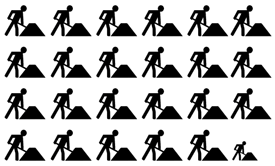 Today's roundup of stimulus coverage:
Today's roundup of stimulus coverage:
Yesterday the administration released its long-awaited rules for counting jobs created by the stimulus, reports the AP. The government's formula is simple: For each stimulus-funded employee, divide the number of hours worked by the number of hours in a full-time schedule. So someone who works full-time for four months would count as one-third of a job. (See Page 33 of yesterday's OMB memo (PDF) for more details.)
The administration also made public what it calls a "one-stop shop for funding recipients to provide their funding information." In other words, it's creating a Web page where recipients of stimulus funds can upload data on how they're spending the money. FederalReporting.gov is currently a filler page with the usual disclaimer and an unusual exclamation point — "The online recipient reporting tool is expected to be available for the quarterly report due October 10, 2009!" You can, however, preview a reporting spreadsheet here (PDF). We look forward to viewing all reports online at Recovery.gov, where OMB Director Peter Orszag promised (PDF) yesterday they would eventually be posted (see Section 2.11).
The Business Insider has assembled a slideshow of the 10 most expensive stimulus road projects using a list prepared by my colleague Michael Grabell. A two-lane tunnel in Oakland, Calif., tops the list at $192 million.
Just a little more than one-half of Americans think the stimulus will correct our economic downturn, according to a new Washington Post-ABC News poll. The poll is conducted monthly; you can see the full results here.
Adding a high-speed rail system to the American landscape won't necessarily change our energy consumption, writes Allison Bush over at Great Lakes Echo, a project of the Knight Center for Environmental Journalism. The federal government has set aside $8 billion in stimulus funds this year for high-speed rail and plans to invest $1 billion annually over the next five years. But unless gas prices skyrocket, argues a researcher from the University of California at Berkeley, people will continue driving to work.










